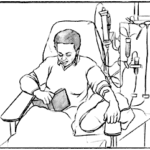 Mortality in long-term hemodialysis patients is mostly attributed to cardiovascular complications, and may be related to chronic inflammation.
Mortality in long-term hemodialysis patients is mostly attributed to cardiovascular complications, and may be related to chronic inflammation.
Researchers at Harbor-UCLA Medical Center, in Torrance, California, hypothesized that the anti-inflammatory benefits of higher dietary intake of omega-3 compared with omega-6 polyunsaturated fatty acids might lower inflammatory processes and decrease the risk of death.
First, the details.
- 145 adult hemodialysis patients participated in the study.
- Their intake of dietary omega-3 and the ratio of omega-6 to omega-3 using a 3-day food record were monitored.
- The 1-year change in serum C-reactive protein (CRP) levels and 6-year survival were recorded.
- CRP is produced by the liver, and the level of CRP rises when there is inflammation throughout the body.
And, the results.
- Each 1-unit higher ratio of omega-6 to omega-3 intake was associated with a significant 0.55-mg/L increase in serum CRP levels.
- However, the risk of death did not change significantly.
The bottom line?
The authors think that using the “3-day food record may underestimate actual dietary fat intake at an individual level.” It might explain the lack of significance in the mortality rate.
They concluded, “Higher dietary omega-6 to omega-3 ratio appears to be associated with both worsening inflammation over time and a [nonstatistically significant] trend toward higher death risk in hemodialysis patients.”
6/13/11 21:40 JR